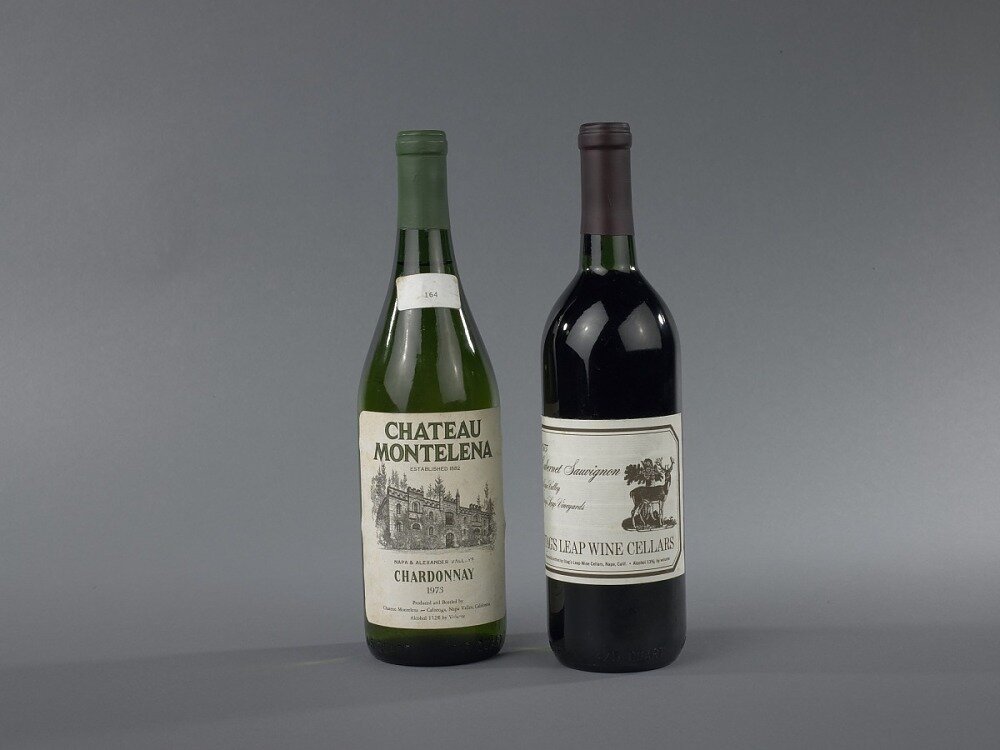
The Californian highlights of the iconic 1976 Judgment of Paris, that held US wines as real contenders to French vintages (photo credit: Museum of American History – Smithsonian Institution)
Hi, dear reader,
I’m Breno, back with wine history and some debates to motivate your fine wine week, no matter if you’re still on quarantine or are finally able to enjoy a little bit more on the outside.
Personally, I’ve been enjoying the sunny early summer weather in Lisbon and going to the beach while I think of my next moves. Safe visits to wineries in Italy back on track? Who knows? Staying safe is the priority, but thankfully a sense of (new) normality seems to be showing up.
* * *
I’ve been meaning to address an interesting topic for a while: Old World, New World. What’s that all about? What makes wines from these two “worlds” different? Are there any best wines for investment when comparing both?
The Old World vs. the New World of wine, explained
Sports metaphor: have you ever watched a friendly match in football, basketball or tennis like “Brazil vs. Rest of world XI”? Those matches usually destined to fundraising?
Well, here we have something that many would call “Europe vs. Rest of the world”. But things are not exactly like this: other regions around the Mediterranean carry a gigantic share of winemaking history (such as North Africa and the Near East). Thanks, Phoenicians!
Heading into practical terms, here’s what you need to know about the Old World and the New World in wine.
READ ALSO: Opus One, the Californian winemaking jewel that merged the Old and the New World
Old World: region and tradition-centered wines
The Old World congregates the birthplaces of wine. From European countries to the Mediterranean basin, one could argue that everything spanning France to Spain to Italy to Germany to Portugal to Austria to Greece to Lebanon to Israel to Croatia to Georgia to Romania to Hungary and Switzerland and more (whew!) could feature in this category.
In very generalistic terms – which do not always apply, since wines from its different countries greatly vary even domestically due to grapes, climate, methods, soil –, Old World wines tend to be lighter-bodied, higher in acidity and lower in alcohol, something usually associated with cooler climates. That comes only regarding general characteristics on its wines, and is many times inaccurate.
Terroir is a major factor here. At the same time, different vintages can show very different results when climatic factors interfere, for examples. Steadiness in modern winemaking techniques, apart from climatic factors, is something you’ll find more in South American wines (from the New World that you’ll read right after).
However, the big thing I see about the Old World, as one could expect to generalize, is the great focus on tradition. The wines from its countries are well known for having a pretty restrictive production, following specific guidelines in accordance with rules that govern the labeling in their regions.
Think of labels: here you’ll find lesser focus on the grapes and more on the origins of the wine. Name, producer, geographical indication (most likely region first, and eventually country). This information is proudly kept as generations go by, highlighting the history behind the winemaking and the bottle itself.
Think of great Bordeaux, Chianti, Rioja, Douro like the ones we offer, for example: you know how good these geographically-oriented wines are, but can you say by heart what grapes compose each? Maybe not at first…
A good example are the interesting specifics you see in French wine, like our Chief Wine Officer Julien Miquel has been exploring lately.
Yes: heritage is how one can define the Old World in very general terms, especially if you think mainstream European wine regions.
New World: migration and winemaking experiments
Instead, when we think of a New World, it could even recall the idea of a New World put forward centuries ago by Vespucci: the new lands, outside the Euro-African realm. In historiographical approaches, this is quite controversial, but that’s another debate!
But here we are not talking only about the American continent: in winemaking, the New World means everything outside the Old World. It includes various countries with vastly different winemaking traditions, such as the United States, Argentina, Chile, Australia, New Zealand, South Africa – and even China, which has strongly rooted traditions that few from the outside know.
All in all, this vast category comprises more of a “migrant” approach in wine: less emphasis on century-old traditions and denominations, with some borrowing and exploring more freely on modern techniques and technology (with many winemakers resting their wines in stainless steel tanks other than oak, for instance), practices, blends – experimentation, should I call it that way.
Also, it is commonly pointed out that New World wines tend to be heavier-bodied, less acidic and substantially fruitier, apart from the minerality you’ll find in some Old-Worlds. A perfect example? The highly prized Montes Folly, the ultra-premium Chilean Syrah we have.
Montes vineyards in Apalta, Chile
There are many who claim the New World wines almost necessarily come from warmer climates, and that this is a preponderant factor in these characteristics. Maybe Argentinians and Chileans from colder regions, and also Mediterranean basin (Old World!) winemakers, will disagree with this generalization. Up for debate!
And, unlike the Old World wines, you won’t find New World labels based on their geographical indication: they will show you upfront the grapes or blends that compose the wine, in a much lesser region-oriented fashion.
However, a curious factor is that, in a globalized world, the winemaking lines are pretty blurred: you’ll find many characteristics of Old World wines in the New World, with (for example) Argentina and Chile picking the best from French grapes and giving deep and interesting approaches to respectively Malbec and Carmenère.
Also, many California wines resemble specific Italian red wines – whilst some Italian regions make savory and fruity vintages.
No dogmas, okay?
